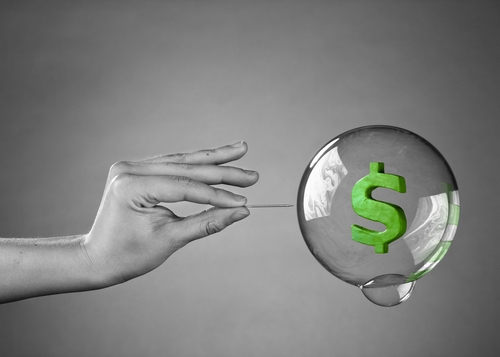
Who would have thought that the year of a major pandemic would be the hottest year for IPOs since 1999? In recent weeks we have fielded a lot of questions about whether buying new IPOs is a good idea. With household names such as Airbnb and DoorDash having gone public in just the last couple of weeks, we decided to investigate how IPOs have done this year vs. historical averages as well as during 1999. 1999 was peak IPO mania in the history of the stock market, and let's see if we can find some similarities and differences to help us make sense of the market today. First, let's do a quick primer on what an IPO is and why companies do an IPO.
What is an IPO?
An IPO, or initial public offering, is when a private company goes public by listing ownership shares of the company on a public exchange, such as the NASDAQ or the New York Stock Exchange. The company typically will sell new shares to the public during an IPO in order to raise capital that it can use to continue growing its business or managing its balance sheets. Some companies don't sell new shares, and these IPOs are called direct listings. Companies go public for a few different reasons. First and foremost, it's a tool to raise capital, as we discussed. Going public also creates liquidity for early investors, early employees, and founders.
How do IPOs work?
A company will hire an investment bank to put together a document called an S-1. This document lays out the story of the company and details the financials, risk factors, and opportunities for the company. The bankers will pitch the company to institutional investors such as hedge funds, endowments, and pension funds. The bankers will gauge investor interest and come up with a price range and amount of new shares to be sold in the IPO to the institutions who sign up. When you see a new company trading for the first time, and you see a percentage gain or decline, it is this offering price that the gain or decline is based on. This is where it gets interesting!
IPOs tend to Pop on Day One
According to the University of Florida Professor and IPO guru, Jay Ritter, the average one day gain of IPOs from 1980 to 2016 is 18%! This pop makes sense when you think about who benefits. When an IPO pops on day one, it typically means the bankers underpriced the IPO. Let's use Airbnb, for example. Airbnb's bankers priced the $51 million new shares to be sold at $68 dollars per share, netting the company $3.5 billion in proceeds. On day one, Airbnb skyrocketed and closed at $144.71. This is the price that the public market was willing to pay. Had Aribnb's bankers priced the IPO at $144.71, the company would have brought in nearly $7.5 billion! That is $4 billion left on the table. When you think about it, modestly underpricing an IPO makes some sense. The banker wants to make the company happy, as well as the investors buying the IPO. The company gets its shareholders off to a great start, and the banker has happy institutional investors who will be more willing to buy what the bankers offer next. In this context, the average one-day gain of 18% makes some sense! However, 2020 is well above that. The average one-day gain for IPOs is 37% in 2020. Let us explore how that lines up versus 1999.
2020 vs. 1999
So far, in 2020, there have been IPOs. This was the most of any year since 1999 when there was 485. The average one-day return of IPOs (excluding SPACs) in 1999 was over 70%, while this year, it is 37%. Looking at the top ten IPOs by offering size, in 1999, not one of the top ten IPOs had a one-day return of less than 350%! The average one-day return of the top ten IPOs in 2020 is 41%. Interestingly though, the average IPO to date return of the top ten in 2020 is 108%!
One critical difference between the two time periods, however, is the quality of the companies IPO-ing. In 1999, you had internet companies that were, more or less, facades without realistic business plans. I was only ten years old at the time, but according to my father (and boss), it was an absolutely hysterical time where the companies coming public were being valued on the number of clicks on their website. Today, the companies coming public are seasoned, legitimate enterprises with legitimate futures. That doesn't make them an attractive investment.
That is not to say what we see today is healthy or normal. Jay Ritter, who we mentioned before, officially thinks we are in an IPO bubble after seeing the Airbnb and DoorDash IPOs. On top of the huge increase in retail participation in the market this year, he sees huge inflows into ETFs that invest exclusively in IPOs. The Renaissance IPO ETF has seen its assets under management balloon to $600 million from $40 million at the start of the year. He sees the modern trend of institutional money chasing what's been performing the best recently as contributing meaningfully to the growing IPO bubble.
What about valuation?
The valuations of recent IPOs are at their highest levels since the dot-com bubble on a price to sales analysis. Investors have valued new IPOs at a median of 23.9 times trailing-twelve-month revenue. For most of the 2010s, the average p/s of a new tech IPO was around six times revenue. FAANG is currently trading at an average of 8 times sales. However, if we want to look where it's getting really frothy, look no farther than some of the hottest "COVID" stocks that seem to rise and fall on COVID case count newsflow. Fff the top of my head, 5 of the highest-flying "covid" stocks I can think of are Zoom (ZM), Peloton (PTON), the Trade Desk (TTD), Docusign (DOCU), and Shopify (SHOP). These five stocks trade at an average of 50 times sales, albeit they are growing quite fast.
The Bottom Line
In my opinion, 2020 is indeed shades of 1999, but it is just that - shades. The companies coming to market this year are healthy, established, and have bright futures. However, we are certainly starting to see some eyebrows raised in the investment community, and there are certainly red flags. The biggest red flags are the huge, well above average one day IPO pops, the huge institutional fund flows into IPO products, and lofty valuations of new IPOs. Sometimes it takes much longer than you expect, but one truth that I have found during my time investing in the markets is that reversion to the mean eventually occurs. If you have been fortunate enough to catch some of the rides higher this year in some IPOs, then that is absolutely wonderful. The only thing I ask is for you to control your risk and remain vigilant. Momentum is your friend until it is not.
We Deliver Content Like This Every Month to Your Inbox. Sign Up to Start Receiving Updates
Related Posts
Asset Location: The Easy Way to Improve Long-Term Outcomes
The Rules-Based Engine that Could
Check out our first episode of "Your Money" with DeWitt Capital Management!
It's All In the Risk: Consistency of Return
It’s All In the Risk: Consistency of Return
We wouldn’t go so far as saying we’ve always had a...

